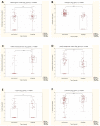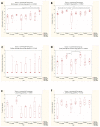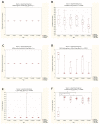Microorganisms Involved in Hydrogen Sink in the Gastrointestinal Tract of Chickens
- PMID: 37047647
- PMCID: PMC10095559
- DOI: 10.3390/ijms24076674
Microorganisms Involved in Hydrogen Sink in the Gastrointestinal Tract of Chickens
Abstract
Hydrogen sink is a beneficial process, which has never been properly examined in chickens. Therefore, the aim of this study was to assess the quantity and quality of microbiota involved in hydrogen uptake with the use of real-time PCR and metagenome sequencing. Analyses were carried out in 50 free-range chickens, 50 commercial broilers, and 54 experimental chickens isolated from external factors. The median values of acetogens, methanogens, sulfate-reducing bacteria (SRB), and [NiFe]-hydrogenase utilizers measured in the cecum were approx. 7.6, 0, 0, and 3.2 log10/gram of wet weight, respectively. For the excreta samples, these values were 5.9, 4.8, 4, and 3 log10/gram of wet weight, respectively. Our results showed that the acetogens were dominant over the other tested groups of hydrogen consumers. The quantities of methanogens, SRB, and the [NiFe]-hydrogenase utilizers were dependent on the overall rearing conditions, being the result of diet, environment, agrotechnical measures, and other factors combined. By sequencing of the 16S rRNA gene, archaea of the genus Methanomassiliicoccus (Candidatus Methanomassiliicoccus) were discovered in chickens for the first time. This study provides some indication that in chickens, acetogenesis may be the main metabolic pathway responsible for hydrogen sink.
Keywords: Campylobacter jejuni; Methanomassiliicoccus; acetogens; chicken gut microbiota; hydrogen uptake; methanogenic archaea; sulfate-reducing bacteria.
Conflict of interest statement
The authors declare no conflict of interest.
Figures




Similar articles
-
Dietary pea fiber increases diversity of colonic methanogens of pigs with a shift from Methanobrevibacter to Methanomassiliicoccus-like genus and change in numbers of three hydrogenotrophs.BMC Microbiol. 2017 Jan 17;17(1):17. doi: 10.1186/s12866-016-0919-9. BMC Microbiol. 2017. PMID: 28095773 Free PMC article.
-
A carvacrol-based product reduces Campylobacter jejuni load and alters microbiota composition in the caeca of chickens.J Appl Microbiol. 2022 Jun;132(6):4501-4516. doi: 10.1111/jam.15521. Epub 2022 Mar 21. J Appl Microbiol. 2022. PMID: 35278017 Free PMC article.
-
Column experiments to assess the effects of electron donors on the efficiency of in situ precipitation of Zn, Cd, Co and Ni in contaminated groundwater applying the biological sulfate removal technology.Environ Sci Pollut Res Int. 2006 Oct;13(6):362-78. doi: 10.1065/espr2005.08.279. Environ Sci Pollut Res Int. 2006. PMID: 17120826
-
Hydrogenases from methanogenic archaea, nickel, a novel cofactor, and H2 storage.Annu Rev Biochem. 2010;79:507-36. doi: 10.1146/annurev.biochem.030508.152103. Annu Rev Biochem. 2010. PMID: 20235826 Review.
-
Several ways one goal-methanogenesis from unconventional substrates.Appl Microbiol Biotechnol. 2020 Aug;104(16):6839-6854. doi: 10.1007/s00253-020-10724-7. Epub 2020 Jun 15. Appl Microbiol Biotechnol. 2020. PMID: 32542472 Free PMC article. Review.
Cited by
-
The inclusion of insect meal from Hermetia illucens larvae in the diet of laying hens (Hy-line Brown) affects the caecal diversity of methanogenic archaea.Poult Sci. 2025 May;104(5):105037. doi: 10.1016/j.psj.2025.105037. Epub 2025 Mar 15. Poult Sci. 2025. PMID: 40120250 Free PMC article.
-
Melatonin feeding changed the microbial diversity and metabolism of the broiler cecum.Front Microbiol. 2024 Aug 19;15:1422272. doi: 10.3389/fmicb.2024.1422272. eCollection 2024. Front Microbiol. 2024. PMID: 39224220 Free PMC article.
-
Editorial of Special Issues "Gut Microbiota-Host Interactions: From Symbiosis to Dysbiosis 2.0".Int J Mol Sci. 2023 May 19;24(10):8977. doi: 10.3390/ijms24108977. Int J Mol Sci. 2023. PMID: 37240323 Free PMC article.
References
MeSH terms
Substances
Grants and funding
LinkOut - more resources
Full Text Sources
Molecular Biology Databases

